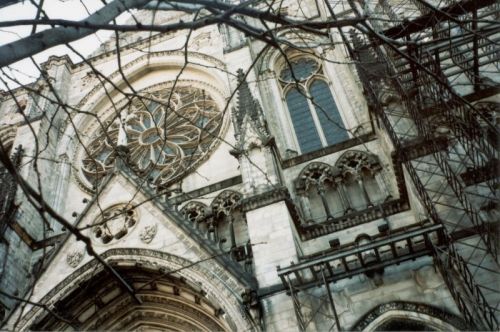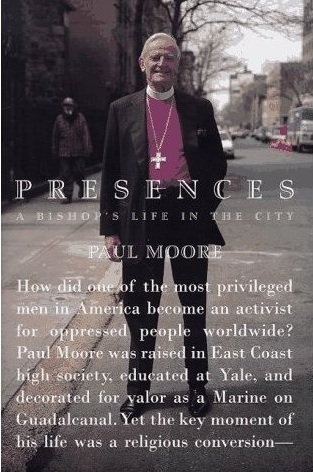 As you might expect, I would like to make a few comments about "The Bishop's Daughter," the buzz-provoking piece in The New Yorker by the poet Honor Moore about the double life lived by her father, the Rt. Rev. Paul Moore Jr., the trailblazing liberal leader of the Diocese of New York from 1972-89.
However, until the magazine elects – we can only hope – to post the full article online, we can only link to a secondary form of revealed wisdom, a news report on the subject printed in the New York Times.
As you might expect, I would like to make a few comments about "The Bishop's Daughter," the buzz-provoking piece in The New Yorker by the poet Honor Moore about the double life lived by her father, the Rt. Rev. Paul Moore Jr., the trailblazing liberal leader of the Diocese of New York from 1972-89.
However, until the magazine elects – we can only hope – to post the full article online, we can only link to a secondary form of revealed wisdom, a news report on the subject printed in the New York Times.
Conservative Anglicans will gag on the headline, "A Bishop Unveiled God's Secrets While Keeping His Own," but let's set that aside for the moment. There is no question that Bishop Moore was one of the most important voices in the history of the U.S. Episcopal Church, especially as the modern patriarch of a powerful family in New York church circles and the city's liberal establishment.
Here's a chunk of the story containing the crucial information:
In an elegiac article in the March 3 issue of The New Yorker magazine titled "The Bishop's Daughter," the poet Honor Moore describes her father, Bishop Moore, who died in 2003 at 83, as alternately passionate and elusive, capable of deep "religious emotion," yet just beyond her emotional reach. It was only after he died, she said, that she fully realized that he had had gay relationships during his two marriages, the first of which produced his nine children. ...
The revelation of his hidden world comes at a time of deep tension within the Episcopal Church of the United States over the issue of homosexuality. Since the church ordained an openly gay bishop in the Diocese of New Hampshire in 2003, a dozen congregations in various parts of the country have withdrawn from the American branch of the church and aligned themselves with theologically conservative African or South American branches of the worldwide Anglican Communion, of which the Episcopal Church is a part.
First of all, there is a clear error in that phrase that says "a dozen congregations in various parts of the country" have withdrawn to align with conservative branches of the Anglican Communion. It is possible that a key word dropped out, or was clipped by an editor. That word would be "several," as in "several dozen congregations." At the very least, there are multiple opinions about what the exit number would be (watch here for reactions at the TitusOneNine weblog).
Now, I realize that once a national church starts splintering, it is hard to keep track of which congregations are headed in which direction and this is certainly true in the complex Anglican diaspora that is unfolding here in North America. Some parishes are leaving and entering the Anglican Mission in America, but not all of them are retaining their old names. There are new missions that are made up of members of old parishes. But is it accurate to say that this is a parish that has left its diocese? People will argue about that.
Then there are the parishes that are forming ties to the traditionalist Anglicans in the Global South, the most obvious example of which is the emerging network linked to Nigeria called CANA – the Convocation of Anglicans in North America. Then there is the American Anglican Council, another network of churches that includes many that are fighting to stay in the Episcopal Church and others that are fighting to get out. Is that a fair way to word it? It's complex.
In other words, in partial defense of the Times, it's hard to come up with a definitive list of churches that have made it all the say out the exit door.
But a dozen? That is way low – bizarre even. To read a conservative analysis of this question, see this post by Father Kendall Harmon at TitusOneNine. Of course he is a partisan. But the numbers are so far off that they are hard to ignore. It would seen that the number is at least 100-plus and, as I mentioned before, that does not include the AMIA numbers or missions that began as pieces of Episcopal parishes. And what about the pending departure of the Episcopal Diocese of San Joaquin?
So it's hard to count all of these apples and oranges. But it is not hard to discover that there are more than a dozen.
 Another issue that interests me in this Moore story, as it did in the fall of the Rev. Ted Haggard, is the degree to which this bishop will now be identified as "gay." As I have asked before, to what degree was this married man – father of nine children – gay? Why isn't his daughter's book evidence that he was "bisexual"?
Another issue that interests me in this Moore story, as it did in the fall of the Rev. Ted Haggard, is the degree to which this bishop will now be identified as "gay." As I have asked before, to what degree was this married man – father of nine children – gay? Why isn't his daughter's book evidence that he was "bisexual"?
I realize that the Times report clearly states that the bishop "had had gay relationships during his two marriages." So a bisexual man had gay relationships. Is the word "gay" being used in this reference in a different way than when "lesbigay" activists discuss the legal status of gays, lesbians and bisexuals?
Finally, there is the way that the piece ends, which strikes me as a bit strange:
Howard Hadley, 62, a member of the church choir who considered himself a friend of the late bishop's, said it came as no surprise to him to learn that Bishop Moore had been involved in gay relationships.
"It was the times he lived in. That's the sad fact. But there was never any doubt in my mind about him," said Mr. Hadley. "People who say they didn't know? Well, you know, people see what they want to see."
The writer of "The Bishop's Daughter" might say that, in some cases at least, people see what they are invited to see.
Is that the end, or was an attributed quote cut off? Who is speaking, in this sentence? When I was in journalism school and learning the ropes in mainstream newsrooms, I was told to avoid speculation in hard news reports.
Then again, perhaps this story is a work of analysis or opinion. Could be.
UPDATE: Hey, the New Yorker link is up. Read it all, as the master Anglican elf would say.
